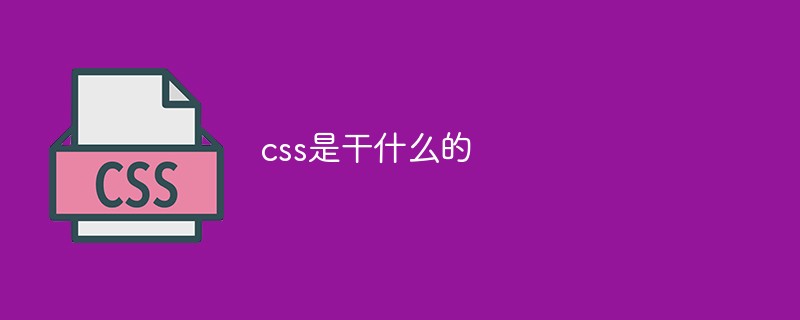
CSS is a style design language that can truly separate the performance and content of web pages. It is mainly used to design the style of web pages and beautify web pages. CSS can perform pixel-level precise control over the layout of element positions in web pages. It can not only statically modify web pages, but also dynamically format various elements of web pages in conjunction with various scripting languages.

The operating environment of this tutorial: Windows 7 system, CSS3 version, Dell G3 computer.
CSS is a computer language used to express document styles such as HTML (an application of Standard Generalized Markup Language) or XML (a subset of Standard Generalized Markup Language). The latest version of CSS is CSS3, which is a style design language that can truly separate web page performance and content.
CSS is mainly used to design the style of web pages and beautify web pages; it can not only statically modify web pages, but also dynamically format various elements of web pages in conjunction with various scripting languages.
Before CSS, almost all presentation properties of an HTML document were contained in HTML markup (especially in HTML tags); all font colors, background styles, element alignment, borders, and sizes had to be in HTML explicit description.
As a result, the development of large websites becomes a long and expensive process as style information is added repeatedly to every page of the website.
In order to solve this problem, the World Wide Web Consortium (W3C) introduced CSS in 1996 and maintained its standards. CSS aims to achieve separation of presentation and content. Web designers can now move a web page's formatting information into a separate style sheet, which makes HTML markup simpler and more maintainable.
Compared with the performance of traditional HTML, CSS can perform pixel-level precise control over the position and layout of objects in web pages, supports almost all font size styles, and has the ability to edit web page objects and model styles. , and can carry out preliminary interaction design. It is currently the best performance design language based on text display.
Using CSS technology when making the homepage can effectively achieve more precise control over the layout, fonts, colors, backgrounds and other effects of the page.
As long as you make some simple modifications to the corresponding code, you can change the appearance and format of different parts of the same page, or web pages with different numbers of pages.
The functions of css can be achieved:
(1) It can be used on almost all browsers.
(2) Some functions that had to be implemented through image conversion in the past can now be easily implemented using CSS, thereby downloading the page faster.
(3) Make the fonts on the page more beautiful and easier to arrange, making the page truly pleasing to the eye.
(4) You can easily control the layout of the page.
(5) You can update the styles and formats of many web pages at the same time, no longer need to update page by page. All web page styles on the site can be controlled using a CSS file. As long as the corresponding lines in the CSS file are modified, all pages of the entire site will change accordingly.
(Learning video sharing: css video tutorial)
The above is the detailed content of What does css do?. For more information, please follow other related articles on the PHP Chinese website!